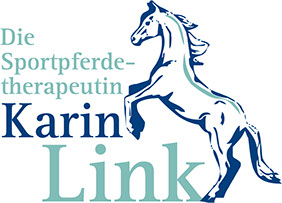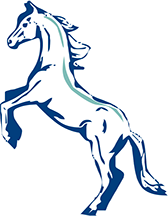

Definition of Equine Sport Therapy
Definition of the types of therapy
Focus & Testing process
Therapeutic process
Definition of the types of therapy
Prices
Curriculum Vitae
Classes and dates
Contact
Legal Notice / Datenschutz

Karin Link · Sportpferdetherapeutin · Postfach 1513 · 53705 Siegburg
Mobil +49 (0) 171 - 40 06 121 · www.karinlink.com
What is TENS and EMS?
TENS stands for transcutaneous electrical nerve stimulation and EMS stands for electrical muscle
stimulation. The great advantages of both therapies are a reduction of pain, a build-up of muscle as
well as improved coordination.
They were originally used in the field of pain therapy. The TENS therapy is based on small, nearly
unnoticeable stimulations that influence the nervous system. They interrupt pain signals and thereby
provide relief. With horses, a deviating type has proven to be very successful.
A nerve receives impulses via a low frequency but a stronger current to contract and relax the
corresponding muscle. A rhythmic pulsing can be observed. Due to the release of endorphins, an
increased state of relaxation begins. The EMS therapy leads to a continuous contraction of the muscle
as a result of increasingly shorter frequency intervals.
The muscular system is then put in a higher state of activity with short intervals of contraction and
relaxation. Using this type of therapy supports the rebuilding process of missing muscles.
Additionally, the muscle “relearns” to contract and relax completely.
What does massage mean?
The massage (from Arabic for “to touch,” the French word masser (“to massage”) or the Greek word
for “chewing” or “kneading”) serves to mechanically influence the skin, connective tissue and muscles.
The skin, which is the largest “organ”, is very sensitive and has many interconnected nerval receptors.
The skin is also needed for temperature regulation (sweat), for detoxication and cutaneous respiration
that corresponds to 0.5–0.8 % of breathing through the lungs. The effect of the massage extends not just
to the treated area but rather throughout the entire organism and even the mind.
Sports massage is an addition to the classic massage. The surface is first calm down and relaxed with extensive, soft techniques, which also serve to build trust. This allows advancing to the deeper layers
and, with stronger, selective techniques to release, the actual hardened area and tissue adhesions.
Each athletic event entails specific problems and needs are adapted on an individual basis.
What is acupressure?
Acupressure is derived from acupuncture and uses the pressure of fingers to stimulate certain points. Acupuncture (Lat.: acus = needle, punctio = stinging) is a segment of traditional Chinese medicine (TCM).
It is based on life energies of the body (Qi), which circulate on specific Bodylines, called meridians, and
have a controlling influence on all functions of the body. An interrupted energy flow is held responsible
for blockages and illnesses. By “stinging” the acupuncture points on the meridians, the energies are
balanced and harmonised.
What are trigger points?
Trigger points are defined as oversensitive and pain-triggering points in the body. Many of these trigger
points are the same as acupuncture points. As opposed to acupuncture points, the trigger points are “sources” of pain and should not be viewed as energy channels. “Active” trigger points weaken the
respective muscle and prevent it from stretching. However, they also “trigger” the pain in areas further
away and disrupt autonomous course of movement. Shortening muscles impair the movement of
adjacent joints and can lead to joint trauma.
Dr. Janet G. Travell (1901–1997) was the first (and most significant) woman who discovered the trigger
points and, among other things, used them to develop the “Myofascial Release” method.
What are stress points?
Similar to trigger points, stress points can be found everywhere in the muscular system of a body.
They are often located where a muscle originates and cause the muscle to tie up, which also shortens it. When pressing one of the stress points, the muscle experience “stress” and often becomes spastic or
vibrates. Jack Meagher developed the stress point massage back in the early 1970s and, in his book
“Beating Muscle Injuries”, he gets to the point of it: “If a muscle is not working for us it is working
against us”.
What is kinesiology?
Applied kinesiology is the umbrella term for the diverse methods now being applied in this field
(“applied kinesiology” from the ancient Greek “kinesis”, which means “movement” and “iologie”,
which means “word, teaching”) and is not to be confused with the “kinesiology” for the science of
movement. The main concepts of kinesiology are based on the assumption that blockages, functional limitations and health defects manifest themselves as weakness in certain groups of muscles.
Kinesiology uses a muscle test as part of its diagnostic method. It is supposed to detect imbalances and dysfunctions of substances, information, emotions and therapies. The muscle test therefore serves as
a “Biofeedback system”. For example, dysfunctions are the result of emotions that cause stress.
Hormones are being released and feelings of paralysis set in, limbs are being confused, etc.
These dysfunctions are counterbalanced by an adjustment and continuatives techniques.
Touch for Healt is one of the original types of kinesiology and groups of muscles are assigned to
meridians. Bodily blockages, energies that are too low or too high are treated with the help of
acupuncture points, wiping off the meridians, reflex points, different neuro-lymphatic and
neuro-vascular massage points.
What is the craniosacral system?
The head (cranium) and the sacrum play a key role in this system. Its basis are the cranial sutures that
are flexibly connected to each other by membranes. The flexibility is created by the flow of the liquor,
the cerebrospinal fluid. It is an independent regulatory system that is responsible for balance and a
healthy functioning of the body. This system has its very own rhythm in the same way that the
respiratory rhythm and the heart rhythm do. They are all systems that, while “independent”,
are also closely related.
Passive mobilisation and stretching techniques:
One of the most effective types of stretching. The muscle group(s) are now in a relaxed and pain-free
state as a result of the preceding, preparatory techniques. A high degree of elasticity of the muscular
system is achieved. An integration of the respiratory rhythm enhances the effect.
Active stretching techniques, e.g. with carrots:
The advantages, in addition to the extension of the outer muscles, especially include an increase
in coordination.
It demands synchronisation as well as the function of letting muscles act both as player
and counterpart.